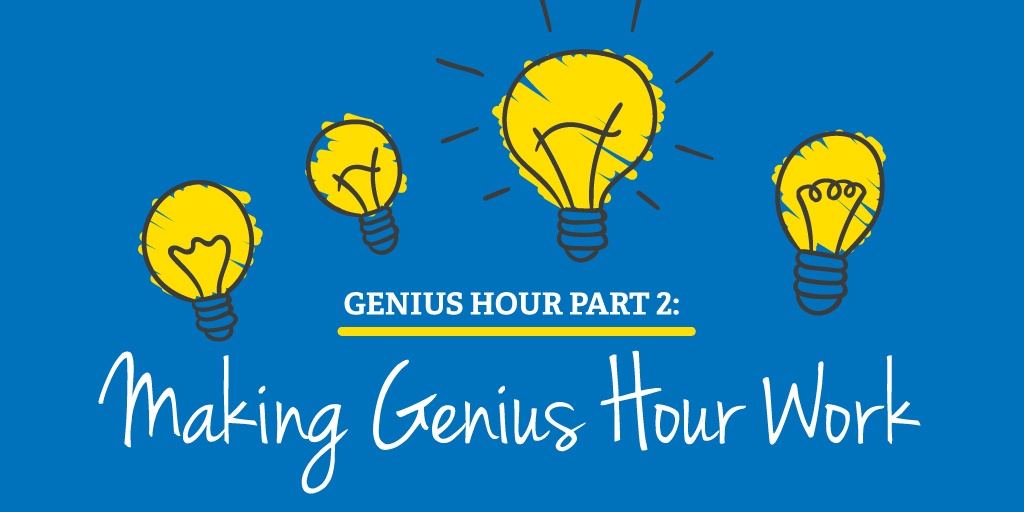
In the first article on Genius Hour, we provided an overview of the philosophy behind genius hour and why teachers should consider trying out the concept. We also gave some considerations for getting started—things like how to schedule the time, the standards to support the learning, and the comfort level with putting it all together.
If a teacher is ready to pull the trigger, what happens next? It is hard to know where to start or what to do. Should I dabble in it or go full steam ahead? Should I start the year with it or wait a few weeks to get routines down? How am I going to grade this—or should I even grade it at all?
Getting Started With Genius Hour
To help your head stop spinning, here are a few ideas for Genius Hour that can help to get the ball rolling and maybe answer some of those questions:
Figure out what you should learn more about: Genius hours are set up in all different fashions and styles. Most of them start with a student generating an idea, concept, or problem that needs to be solved—it’s helpful if the teacher models this process for the students. Brainstorming interests and things that we find motivating is a great place to start. It's important to remember Daniel Pink’s research from Drive about intrinsic motivation and the three major factors: purpose, mastery, and autonomy. Defining the problem is the autonomy part, and each student will have an individualized area that they will become a “genius” about.
Plan for the planning: How are students going to get started? This basic question is a little more complex than it seems. Students with more structure at the beginning will likely have more success in the long run—especially if the entire concept is new to the students (our experience is that once students get the hang of it, the planning stages look a little different). Teachers should provide brainstorming documents and graphic organizers to document the thinking through the initial planning stages. These are great to reflect on after project completion to see how the project may have changed over time.
Determine what “mastery” will look like: This can be the critical component for the entire concept of genius hour. As a student develops a plan to learn more about an idea or concept, the teacher must keep the standards in mind (remember, this was #1 in the first part of this series). During this process, the teacher can coach the student into using skills from the standards to learn the content (reading, listening, research, and science standards) as well as the standards to communicate the content to an audience (speaking, writing, art, and technology standards). I have seen complex formats of this with checklists of all the standards to document the learning. I have also seen an informal assessment of this that is much more broad. There isn’t a “right” answer, but the teacher should know which standards are being learned for each student.
Spend time conferencing: Once the modeling has been completed and the brainstorming has started, the students will begin to engage in the “work” of the project. At this time, the teacher becomes the facilitator of the learning, coaching and conferencing with individual students a few times a week (at a minimum). This takes a lot of engagement and energy, but is well worth it to see how excited the students are as they dive in. Again, I have seen the gamut from general notes about the learning to very specific conferencing forms for teachers and students to complete. I would highly encourage daily student reflection regardless of the format—this metacognition is important for students to learn.
Presenting and assessing: This can be really tricky. If we want students to have a true sense of autonomy and mastery, we don’t want to come across as the “judge” of the learning by giving a grade. This is really the opposite of the philosophy of genius hour. There are other options: students can create their own rubrics of expectations, they can self-assess, or they can provide evidence to the teacher of how they mastered each of the standards.
Bonus points for finding purpose: We haven’t talked much about purpose—the third factor of how students are motivated intrinsically. This isn’t an essential part to genius hour, but it can add real relevance to the learning. Students can learn about something they are interested in, but if they are able to connect it to something in the community or world, it is that much more engaging. This can be a great point of conversation when conferencing with students by asking, “How can you take this learning and make an impact in the community?”
This list isn’t all inclusive, but it does cover some of the big questions that have come up with teachers who have ventured into genius hour. A good comprehensive resource can be found at this Genius Hour site, which offers a free webinar to get you started in the classroom if this project is of interest to you.
Hopefully by giving students some freedom in their learning and some time to master skills, they will become more motivated and will learn the standards easily and more deeply than ever before.
For more teaching tips, and to stay up to date with the latest trends in education and educational technology, be sure to subscribe to our Educator blog.



